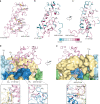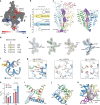Structure of voltage-modulated sodium-selective NALCN-FAM155A channel complex
- PMID: 33273469
- PMCID: PMC7712781
- DOI: 10.1038/s41467-020-20002-9
Structure of voltage-modulated sodium-selective NALCN-FAM155A channel complex
Abstract
Resting membrane potential determines the excitability of the cell and is essential for the cellular electrical activities. The NALCN channel mediates sodium leak currents, which positively adjust resting membrane potential towards depolarization. The NALCN channel is involved in several neurological processes and has been implicated in a spectrum of neurodevelopmental diseases. Here, we report the cryo-EM structure of rat NALCN and mouse FAM155A complex to 2.7 Å resolution. The structure reveals detailed interactions between NALCN and the extracellular cysteine-rich domain of FAM155A. We find that the non-canonical architecture of NALCN selectivity filter dictates its sodium selectivity and calcium block, and that the asymmetric arrangement of two functional voltage sensors confers the modulation by membrane potential. Moreover, mutations associated with human diseases map to the domain-domain interfaces or the pore domain of NALCN, intuitively suggesting their pathological mechanisms.
Conflict of interest statement
The authors declare no competing interests.
Figures





Similar articles
-
Structure and mechanism of NALCN-FAM155A-UNC79-UNC80 channel complex.Nat Commun. 2022 May 12;13(1):2639. doi: 10.1038/s41467-022-30403-7. Nat Commun. 2022. PMID: 35550517 Free PMC article.
-
Structure of the human sodium leak channel NALCN.Nature. 2020 Nov;587(7833):313-318. doi: 10.1038/s41586-020-2570-8. Epub 2020 Jul 22. Nature. 2020. PMID: 32698188
-
Structure of the human sodium leak channel NALCN in complex with FAM155A.Nat Commun. 2020 Nov 17;11(1):5831. doi: 10.1038/s41467-020-19667-z. Nat Commun. 2020. PMID: 33203861 Free PMC article.
-
New insights into the physiology and pathophysiology of the atypical sodium leak channel NALCN.Physiol Rev. 2024 Jan 1;104(1):399-472. doi: 10.1152/physrev.00014.2022. Epub 2023 Aug 24. Physiol Rev. 2024. PMID: 37615954 Review.
-
Selectivity filters and cysteine-rich extracellular loops in voltage-gated sodium, calcium, and NALCN channels.Front Physiol. 2015 May 19;6:153. doi: 10.3389/fphys.2015.00153. eCollection 2015. Front Physiol. 2015. PMID: 26042044 Free PMC article. Review.
Cited by
-
Unplugging lateral fenestrations of NALCN reveals a hidden drug binding site within the pore region.Proc Natl Acad Sci U S A. 2024 May 28;121(22):e2401591121. doi: 10.1073/pnas.2401591121. Epub 2024 May 24. Proc Natl Acad Sci U S A. 2024. PMID: 38787877 Free PMC article.
-
Contributions of the Sodium Leak Channel NALCN to Pacemaking of Medial Ventral Tegmental Area and Substantia Nigra Dopaminergic Neurons.J Neurosci. 2023 Oct 11;43(41):6841-6853. doi: 10.1523/JNEUROSCI.0930-22.2023. Epub 2023 Aug 28. J Neurosci. 2023. PMID: 37640554 Free PMC article.
-
Structure and mechanism of NALCN-FAM155A-UNC79-UNC80 channel complex.Nat Commun. 2022 May 12;13(1):2639. doi: 10.1038/s41467-022-30403-7. Nat Commun. 2022. PMID: 35550517 Free PMC article.
-
Architecture of the human NALCN channelosome.Cell Discov. 2022 Apr 6;8(1):33. doi: 10.1038/s41421-022-00392-4. Cell Discov. 2022. PMID: 35387979 Free PMC article.
-
Structural architecture of the human NALCN channelosome.Nature. 2022 Mar;603(7899):180-186. doi: 10.1038/s41586-021-04313-5. Epub 2021 Dec 20. Nature. 2022. PMID: 34929720
References
Publication types
MeSH terms
Substances
LinkOut - more resources
Full Text Sources
Other Literature Sources
Molecular Biology Databases


